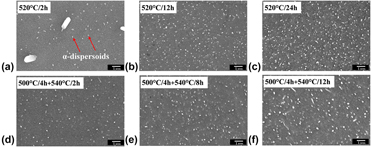Crossref Citations
This article has been cited by the following publications. This list is generated based on data provided by
Crossref.
Chen, S.
Liu, K.
and
Chen, X.-G.
2020.
Light Metals 2020.
p.
261.
Li, Dong
Liu, Kun
Chen, X-Grant
De Geuser, F.
Deschamps, A.
Ehrström, J.-C.
Jarry, P.
Salloum-Abou-Jaoude, G.
Salvo, L.
and
Sigli, C.
2020.
Influence of transition elements (V, Zr and Mo) and cooling rate on the precipitation of dispersoids in Al-7Si-0.6Cu-0.35Mg foundry alloy.
MATEC Web of Conferences,
Vol. 326,
Issue. ,
p.
02003.
Liu, K.
Li, C.
Chen, X.-G.
De Geuser, F.
Deschamps, A.
Ehrström, J.-C.
Jarry, P.
Salloum-Abou-Jaoude, G.
Salvo, L.
and
Sigli, C.
2020.
Evolution of microstructure and elevated-temperature properties during hot rolling and post-rolling annealing process in Al-Mg-Si 6082 alloys.
MATEC Web of Conferences,
Vol. 326,
Issue. ,
p.
03001.
Shu, Shipeng
De Luca, Anthony
Dunand, David C.
and
Seidman, David N.
2021.
Individual and synergistic effects of Mn and Mo micro-additions on precipitation and strengthening of a dilute Al–Zr-Sc-Er-Si alloy.
Materials Science and Engineering: A,
Vol. 800,
Issue. ,
p.
140288.
Pan, Yong
and
Yu, Ende
2021.
First-principles investigation of structural stability, mechanical and thermodynamic properties of Pt3Zr5 compounds.
Physica B: Condensed Matter,
Vol. 611,
Issue. ,
p.
412936.
Gariboldi, Elisabetta
Confalonieri, Chiara
and
Colombo, Marco
2021.
High Temperature Behavior of Al-7Si-0.4Mg Alloy with Er and Zr Additions.
Metals,
Vol. 11,
Issue. 6,
p.
879.
Liu, Kun
Wang, Shuai
Hu, Peng
Pan, Lei
and
Chen, X. Grant
2023.
Proceedings of the 62nd Conference of Metallurgists, COM 2023.
p.
257.
Liu, Kun
Wang, Shuai
Hu, Peng
Pan, Lei
and
Chen, X.-Grant
2023.
Improved Thermo-Mechanical Fatigue Resistance of Al-Si-Cu 319 Alloys by Microalloying with Mo.
Materials,
Vol. 16,
Issue. 9,
p.
3515.
Liu, Kun
Wang, Shuai
Pan, Lei
and
Chen, X.-Grant
2023.
Thermo-Mechanical Fatigue Behavior and Resultant Microstructure Evolution in Al-Si 319 and 356 Cast Alloys.
Materials,
Vol. 16,
Issue. 2,
p.
829.
Li, Dong
Liu, Kun
and
Chen, X-Grant
2023.
Evolution of Microstructure and Elevated-Temperature Properties during Thermal Exposure with Transition Elements (V, Zr and Mo) in Al–Si 356 Type Cast Alloys.
MATERIALS TRANSACTIONS,
Vol. 64,
Issue. 2,
p.
406.
Liu, Kun
Wang, Zimeng
Pan, Lei
and
Chen, X.-Grant
2024.
Influence of Si on the Elevated-Temperature Mechanical and Creep Properties of Al–Cu 224 Cast Alloys during Thermal Exposure.
Materials,
Vol. 17,
Issue. 19,
p.
4805.
Österreicher, Johannes A.
Živanović, Dragan
Walenta, Wolfram
Maimone, Stefan
Hofbauer, Manuel
Hovden, Sindre
Tükör, Zuzana
Arnoldt, Aurel
Cerny, Angelika
Kronsteiner, Johannes
Antić, Miloš
Zickler, Gregor A.
Ehmeier, Florian
Mikulović, Milomir
and
Kunschert, Georg
2024.
In situ conductometry for studying the homogenization of Al-Mg-Si alloys and predicting extrudate grain structure through machine learning.
Materials & Design,
Vol. 243,
Issue. ,
p.
113070.
Cui, Liying
Liu, Kun
and
Chen, X.-Grant
2025.
Recent advances in cost-effective aluminum alloys with enhanced mechanical performance for high-temperature applications: A review.
Materials & Design,
p.
113869.
Zhu, Na
Zhang, Xudong
Wang, Feng
and
Guo, Yongxin
2025.
Exploring the structural,electronic, elastic and thermodynamic properties of TM5Sn2Si (TM=Nb, Cr, W, Mo, Ti, Re) based on first-principles calculations.
Journal of Physics and Chemistry of Solids,
Vol. 201,
Issue. ,
p.
112639.
